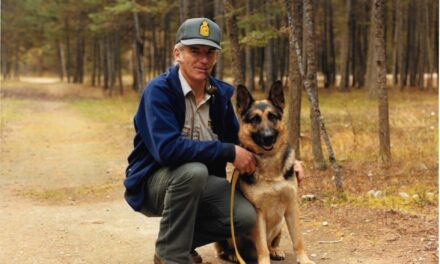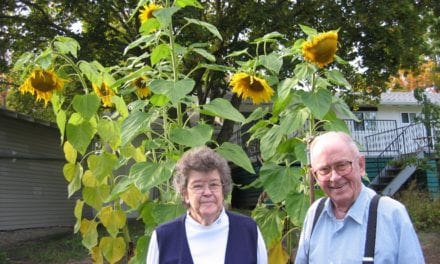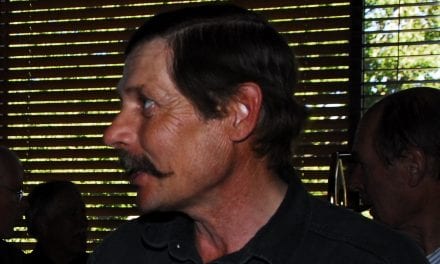(0:17:42) In 1980 I was assigned as the wildlife warden. That when you really think about it, was kind of the very primary start into the resource management, which would eventually become a science program several years down the road. We conducted systematic surveys on wildlife using both aerial surveys and ground surveys. We eventually replaced the old system of recording data using a new computer system called “The Kansas System” That was the first computer cards for wildlife. They shipped us to Ottawa for a week to look at this computer system. I remember walking into the room and it was a room the size of the living room here. These computers would be as high as the door. All this whirling and whizzing going on, the wheels turning and that type of stuff. They had this huge platform where they could draw different wildlife sightings…When I look back it was very primitive, but it was a start.
(0: 19:41) We did a lot of experimenting then with different immobilizing drugs. When I first came to Lake Louise we used a drug called Anectine, it was very unpredictable and very dangerous to handle. If you ever got hit with it, you were in big trouble…I remember there were some people viewing this bear that we had just immobilized in the cage. They were asking questions about the drug. “What do you use?” Monty said, “This is Anectine and if you ever get hit with it, the thing you do first is bend down really low and put your head between your legs.” They all looked at him kind of startled and then he said, “And kiss your ass good-bye!” This was a bunch of interpretive people that had come! Monty had an unusual sense of humor, which lightened things up quite a lot! That was in the Lake Louise days.
(0:20:51) One thing that I would like to say is that yes my job was getting more specialized but I still required to perform all the duties. I was required to do the law enforcement, the public safety etc. That didn’t change…
(0:21 :20) I left Lake Louise in 1976, to go to Banff. It would be close to 1980 when the ecological land classification started. A lot of the wardens were part of that team. At the same time, Steve Herrero was doing a lot of work with the grizzly bears. Before that everything pretty much on the scientific end was done with the Canadian Wildlife Service. Most of us felt that as land managers we should be more involved with the actual resource management. That was a change that was coming on. The Canadian Wildlife Service still stayed involved, but not as much…The wardens started to get more involved with resource management decisions. Cliff White started his work on prescribed burns. It was very controversial at the time. It took a lot of courage to pull that through. Cliff’s program became the standard for other agencies to follow.
(0:22:30) In 1980, I got the job as backcountry supervisor and Rick Kunelius took over for me as the wildlife warden. I had felt at that time that my education was probably being really challenged for where the science program was going. I mean I had a good practical background and I really knew the park by this time concerning the wildlife, but real computer programs were coming in earnest then and that type of stuff. I just felt too that it was time to probably move on….If we were going to take over the responsibility from the Canadian Wildlife Service, we needed more scientific educated wardens.
(0:23:07) Talking about how wardens responded to things … with public safety it was probably as intense in the mountain parks as it was anywhere in North America. Mountain climbers, skiers and all the things that were going on…The training program then was you started as beginner, then you were intermediate and then advanced. Well, the way we had it set up was everyone went through the beginner and some 50 or 60% got up the intermediate level, and then there was the advanced level which would be a few of the people. It was very well organized. Like I say that public safety team became one of the best in the world over time.
(0:24:07) So anyway, I decided that I would take that job as the front country supervisor and I went to a GT3. It was a promotion, so to speak. I knew what I was getting into, but I’ll tell you it was really interesting because I forget how many wardens we had in the front country. The campgrounds had really blown up to where several wardens were hired just to keep the peace. For want of a better word, we called them the “Campground Cowboys”! Every one of those people that went through that for a couple of years became some of our best enforcement wardens … A typical day as a supervisor of the front country was unbelievable! There would be bears every morning so you had to do something. There would be people to go up and kick out of the campground … It just went on and on! Then a rescue…It was just goofy, but I loved it! I have to say that there was never a dull day! When you went to work in the morning you could be sure that a few really weird things sure to come up
(0:25:25) This next story involved your dad (warden Keith Everts) and I. At 3:00 in the morning Keith called me. He said, ‘We just had a bear mauling in Banff. I will pick you up. They had the guy in the hospital. As soon as we walked in, we were suspicious that something wasn’t right here. He had his nose crushed and he had a few scratches and a bump on the head and that type of stuff. He claimed that he had been mauled by a grizzly bear near the cadet camp that was when the cadet camp used to be right below Cascade Mountain. The guy worked for them as a cook or something, as I recall. So anyway, he didn’t have a shirt on. I asked one of the cadet officers “Where’s his shirt?” They said, “It’s back in camp.” I said, “Well we want that shirt because if there are grizzly hairs on it, we want to see it.” But we were suspicious right off the bat. As we walked out, Keith and I were going to follow him back to get his shirt and try to go to the site where he supposedly got mauled. We ran a CPIC check on the guy with the RCMP. In a few minutes they got back to us and said, “Well, as soon as you stop, arrest him because this guy has got an outstanding warrant.” When we stepped out of the truck Keith and I arrested him. Then we took him in. Well that guy turned out to be a serial rapist out of Ontario. Why he would have drawn that kind of attention to himself, I don’t know? There was never a bear attack. We found out later that he had gotten punched out…that’s just an example of how different this job could be…
(0:27:29) When I moved into the front country job, (chief warden) Andy Anderson left soon after… to be a coordinator for the TransCanada highway and Gaby Fortin became chief. One of his priorities was to start building up the law enforcement. We took more training all the time then and we brought in people. We actually created a law enforcement coordinator position. Peter Enderwick was instrumental in helping set up the program.
(0:28:00) Some of the highlights, just to give you an idea of what the law enforcement was like, was an incident turned out to be an international affair. It was called the Shipsey case. He was an American, who came into Banff Park to poach. Banff wasn’t the only one having these problems. This was across the mountain parks…We happened to just trip onto this. They killed an elk out by Hillsdale Meadows. We were lucky enough it was John Wackerle and I that we came upon it. An elk was just shot, the head was stripped off and gone (the rest of the carcass was left). We were losing five to six elk off the TransCanada between there and Lake Louise every year…I could write a book on this one as well… Eventually we tied it into this guy out of Wasa BC that was the guide. What happened was they were coming into the park. He actually had a book that we seized later on in San Francisco and eventually traced it right on through back to him in BC… It took a year to bring it to court, but it was a huge international case. They were getting ten thousand dollars a night to bring people into the parks. The stuff was shipped into the States … It was a major case and by the time it was done, it involved BC Fish and Wildlife, Alberta Fish and Wildlife, California Fish and Wildlife, the Banff and Jasper warden service and the U.S. Federal Department of Fish and Wildlife. It took over a year to bring it all to court.
(0:29:57) Then there was another situation this would be about the \mid 1980s just to give you another example of what kind of law enforcement was going on. An informant called me and told me about a French national with a party coming up from Montana. They were going to stay on the Great Divide all the way through. They were going to be coming into Banff and they would be taking game as they needed it. At first I didn’t think much of it because it was quite common to get crank phone calls. He called me back about a week later again and then I started taking it seriously. This guy, who we never ever did know who he was, told us when they would be coming into Banff National Park…Diane Volkers and another warden went in undercover to see if they actually did come into the park. Sure enough the informant was right and we apprehended the group on the Palliser River flats. It was two German hunters, a guy from Belgium and if I ever met an Indiana Jones, this guy was him. I couldn’t help, but kind of like him! They had been on the trail for over 30 days. They had a veterinarian traveling with them, it was very well organized. We could never get the Canadian contacts out of him. But anyway he told me after we charged him, and that was before the big fines that came in 1988, he told me that he had been through the year before with a group. That’s just another example. Law enforcement was really coming along. We were getting a lot of training in and a lot of respect from the outside agencies that were sharing information with us. I think that was about 1986, we were making the turn then and getting a lot more professional in law enforcement. I was still the front country supervisor then.
NOTE: (What made the law enforcement so important and why we really had to smarten up was because in 1988 the national parks act changed. It changed to what they called a dual procedure, which was summary conviction and indictable which was criminal…That changed the law enforcement. Before there had been a $500 fine which didn’t stop anybody. Now when this came in, it demanded that we got a lot more professional, better as investigators and better in \court, more training etc … Yes, we used to have to prosecute our own cases. Of course the only way most of us knew how to do
that was watching Perry Mason on TV! That didn’t last too long, but when you were the court warden you had to write up all the info etc. Four years later they changed the system: They had lawyers that actually were contracted to us… I often look back and Judge Aunger was there then and he was very patient with us, he was! He knew that we were put into a position that we didn’t really want to be in.)



